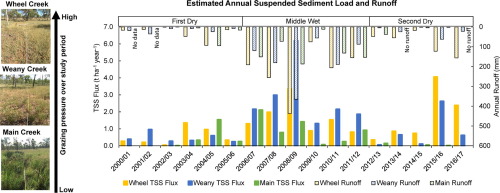当前位置:
X-MOL 学术
›
J. Hydrol.
›
论文详情
Our official English website, www.x-mol.net, welcomes your
feedback! (Note: you will need to create a separate account there.)
Effects of reduced grazing pressure on sediment and nutrient yields in savanna rangeland streams draining to the Great Barrier Reef
Journal of Hydrology ( IF 5.9 ) Pub Date : 2020-03-01 , DOI: 10.1016/j.jhydrol.2019.124520 Jack Koci , Roy C. Sidle , Anne E. Kinsey-Henderson , Rebecca Bartley , Scott N. Wilkinson , Aaron A. Hawdon , Ben Jarihani , Christian H. Roth , Luke Hogarth
Journal of Hydrology ( IF 5.9 ) Pub Date : 2020-03-01 , DOI: 10.1016/j.jhydrol.2019.124520 Jack Koci , Roy C. Sidle , Anne E. Kinsey-Henderson , Rebecca Bartley , Scott N. Wilkinson , Aaron A. Hawdon , Ben Jarihani , Christian H. Roth , Luke Hogarth

|
Excess sediment and nutrient yields from degraded rangelands have detrimental off-site ecological and on-site economic impacts, yet the effect of reduced grazing pressure on water quality is not fully understood. This study compares 15-year records of runoff, sediment and nutrient yields amongst three ephemeral headwater catchments (10.5–13.5 km2) with similar wet/dry tropical climate and landform characteristics, but contrasting cattle grazing pressure. The catchments are located within the Burdekin River basin which is the largest source of sediment and particulate nutrients to the Great Barrier Reef, Australia. Estimated mean annual total suspended sediment (TSS), total nitrogen (TN) and total phosphorus (TP) loads are: 0.6 t ha−1, 1.3 and 0.3 kg ha−1, respectively, in a catchment from which cattle were excluded over the study period (‘Main Creek’); 1.5 t ha−1, 1.4 and 0.4 kg ha−1, respectively, in a catchment where grazing pressure was reduced from approximately 25 to 13 cattle per km2 at the commencement of monitoring (‘Weany Creek’); and 1.4 t ha−1, 3.0 and 0.5 kg ha−1, respectively, in a catchment which maintained higher levels of grazing pressure (‘Wheel Creek’, approximately 25 head per km2). Higher annual sediment loads in the grazed catchments compared to the ungrazed catchment are likely due to degradation of soil water storage capacity, soil surface protection and gully erosion rates, but could also be influenced by differences in catchment geomorphic attributes (e.g., hydrological and sediment connectivity). Events with runoff >20 mm (16–25% of all events) generated 79–85% of the total runoff volume and 71–78% of the total TSS, TN, and TP loads. At the event timescale, there are not clear differences in runoff, sediment and nutrient loads among the catchments, attributed to variability in catchment conditions (e.g., antecedent soil moisture, rainfall intensity, vegetation) that occur within- and between events. It is concluded that recovery of degraded savanna rangelands following reduction in livestock grazing pressure takes decades and is strongly influenced by climate. Measuring water quality responses to land management change in variable climates requires nested spatial monitoring over long time scales that also includes factors that can influence the response (e.g., climate, soil properties, vegetation and land use).
中文翻译:

减少放牧压力对流入大堡礁的稀树草原牧场河流中的沉积物和养分产量的影响
退化牧场的过量沉积物和养分产量会对场外生态和场内经济产生不利影响,但尚未完全了解放牧压力降低对水质的影响。本研究比较了三个具有相似湿/干热带气候和地貌特征,但牛放牧压力不同的短暂源头集水区(10.5-13.5 平方公里)的 15 年径流、沉积物和养分产量记录。集水区位于伯德金河流域内,该河流域是澳大利亚大堡礁最大的沉积物和颗粒养分来源。估计的年平均总悬浮泥沙 (TSS)、总氮 (TN) 和总磷 (TP) 负荷分别为:0.6 t ha-1、1.3 和 0.3 kg ha-1,在研究期间排除牛的流域(“主溪”);在监测开始时放牧压力从每平方公里约 25 头牛减少到 13 头牛的集水区(“Weany Creek”)分别为 1.5 t ha-1、1.4 和 0.4 kg ha-1;和 1.4 t ha-1、3.0 和 0.5 kg ha-1,在保持较高放牧压力的集水区('Wheel Creek',大约每平方公里 25 头)。与未放牧的集水区相比,放牧集水区的年泥沙负荷较高可能是由于土壤蓄水能力、土壤表面保护和沟渠侵蚀率的退化,但也可能受到集水区地貌属性差异(例如,水文和沉积物连通性)的影响)。径流事件 > 20 毫米(所有事件的 16-25%)产生了总径流量的 79-85% 和总 TSS、TN 和 TP 负荷的 71-78%。在事件时间尺度上,流域之间的径流、沉积物和养分负荷没有明显差异,这归因于事件内部和事件之间发生的流域条件(例如,前期土壤湿度、降雨强度、植被)的可变性。结论是,随着牲畜放牧压力的减少,退化的稀树草原牧场的恢复需要几十年的时间,并且受到气候的强烈影响。在可变气候条件下测量土地管理变化的水质响应需要长期嵌套的空间监测,其中还包括可能影响响应的因素(例如,气候、土壤特性、植被和土地利用)。和 TP 负载。在事件时间尺度上,流域之间的径流、沉积物和养分负荷没有明显差异,这归因于事件内部和事件之间发生的流域条件(例如,前期土壤湿度、降雨强度、植被)的可变性。结论是,随着牲畜放牧压力的减少,退化的稀树草原牧场的恢复需要几十年的时间,并且受到气候的强烈影响。在可变气候条件下测量土地管理变化的水质响应需要长期嵌套的空间监测,其中还包括可能影响响应的因素(例如,气候、土壤特性、植被和土地利用)。和 TP 负载。在事件时间尺度上,流域之间的径流、沉积物和养分负荷没有明显差异,这归因于事件内部和事件之间发生的流域条件(例如,前期土壤湿度、降雨强度、植被)的可变性。结论是,随着牲畜放牧压力的减少,退化的稀树草原牧场的恢复需要几十年的时间,并且受到气候的强烈影响。在可变气候条件下测量土地管理变化的水质响应需要长期嵌套的空间监测,其中还包括可能影响响应的因素(例如,气候、土壤特性、植被和土地利用)。归因于发生在事件内部和事件之间的流域条件(例如,前期土壤湿度、降雨强度、植被)的可变性。结论是,随着牲畜放牧压力的减少,退化的稀树草原牧场的恢复需要几十年的时间,并且受到气候的强烈影响。在可变气候条件下测量土地管理变化的水质响应需要长期嵌套的空间监测,其中还包括可能影响响应的因素(例如,气候、土壤特性、植被和土地利用)。归因于事件内部和事件之间发生的流域条件(例如,前期土壤湿度、降雨强度、植被)的可变性。结论是,随着牲畜放牧压力的减少,退化的稀树草原牧场的恢复需要几十年的时间,并且受到气候的强烈影响。在可变气候条件下测量土地管理变化的水质响应需要长期嵌套的空间监测,其中还包括可能影响响应的因素(例如,气候、土壤特性、植被和土地利用)。
更新日期:2020-03-01
中文翻译:

减少放牧压力对流入大堡礁的稀树草原牧场河流中的沉积物和养分产量的影响
退化牧场的过量沉积物和养分产量会对场外生态和场内经济产生不利影响,但尚未完全了解放牧压力降低对水质的影响。本研究比较了三个具有相似湿/干热带气候和地貌特征,但牛放牧压力不同的短暂源头集水区(10.5-13.5 平方公里)的 15 年径流、沉积物和养分产量记录。集水区位于伯德金河流域内,该河流域是澳大利亚大堡礁最大的沉积物和颗粒养分来源。估计的年平均总悬浮泥沙 (TSS)、总氮 (TN) 和总磷 (TP) 负荷分别为:0.6 t ha-1、1.3 和 0.3 kg ha-1,在研究期间排除牛的流域(“主溪”);在监测开始时放牧压力从每平方公里约 25 头牛减少到 13 头牛的集水区(“Weany Creek”)分别为 1.5 t ha-1、1.4 和 0.4 kg ha-1;和 1.4 t ha-1、3.0 和 0.5 kg ha-1,在保持较高放牧压力的集水区('Wheel Creek',大约每平方公里 25 头)。与未放牧的集水区相比,放牧集水区的年泥沙负荷较高可能是由于土壤蓄水能力、土壤表面保护和沟渠侵蚀率的退化,但也可能受到集水区地貌属性差异(例如,水文和沉积物连通性)的影响)。径流事件 > 20 毫米(所有事件的 16-25%)产生了总径流量的 79-85% 和总 TSS、TN 和 TP 负荷的 71-78%。在事件时间尺度上,流域之间的径流、沉积物和养分负荷没有明显差异,这归因于事件内部和事件之间发生的流域条件(例如,前期土壤湿度、降雨强度、植被)的可变性。结论是,随着牲畜放牧压力的减少,退化的稀树草原牧场的恢复需要几十年的时间,并且受到气候的强烈影响。在可变气候条件下测量土地管理变化的水质响应需要长期嵌套的空间监测,其中还包括可能影响响应的因素(例如,气候、土壤特性、植被和土地利用)。和 TP 负载。在事件时间尺度上,流域之间的径流、沉积物和养分负荷没有明显差异,这归因于事件内部和事件之间发生的流域条件(例如,前期土壤湿度、降雨强度、植被)的可变性。结论是,随着牲畜放牧压力的减少,退化的稀树草原牧场的恢复需要几十年的时间,并且受到气候的强烈影响。在可变气候条件下测量土地管理变化的水质响应需要长期嵌套的空间监测,其中还包括可能影响响应的因素(例如,气候、土壤特性、植被和土地利用)。和 TP 负载。在事件时间尺度上,流域之间的径流、沉积物和养分负荷没有明显差异,这归因于事件内部和事件之间发生的流域条件(例如,前期土壤湿度、降雨强度、植被)的可变性。结论是,随着牲畜放牧压力的减少,退化的稀树草原牧场的恢复需要几十年的时间,并且受到气候的强烈影响。在可变气候条件下测量土地管理变化的水质响应需要长期嵌套的空间监测,其中还包括可能影响响应的因素(例如,气候、土壤特性、植被和土地利用)。归因于发生在事件内部和事件之间的流域条件(例如,前期土壤湿度、降雨强度、植被)的可变性。结论是,随着牲畜放牧压力的减少,退化的稀树草原牧场的恢复需要几十年的时间,并且受到气候的强烈影响。在可变气候条件下测量土地管理变化的水质响应需要长期嵌套的空间监测,其中还包括可能影响响应的因素(例如,气候、土壤特性、植被和土地利用)。归因于事件内部和事件之间发生的流域条件(例如,前期土壤湿度、降雨强度、植被)的可变性。结论是,随着牲畜放牧压力的减少,退化的稀树草原牧场的恢复需要几十年的时间,并且受到气候的强烈影响。在可变气候条件下测量土地管理变化的水质响应需要长期嵌套的空间监测,其中还包括可能影响响应的因素(例如,气候、土壤特性、植被和土地利用)。











































 京公网安备 11010802027423号
京公网安备 11010802027423号